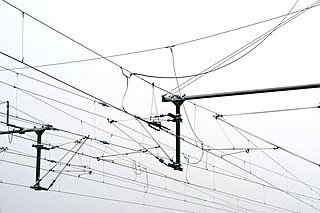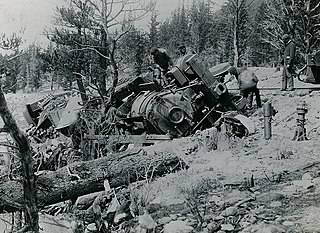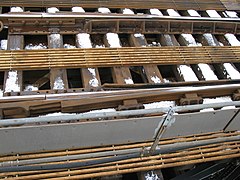- Expansion joint on Williamsburg Bridge, New York City Subway
- A breather switch on a TGV line
- An expansion joint on the Cornish Main Line, England
Related Research Articles

Rail transport is a means of transport that transfers passengers and goods on wheeled vehicles running on rails, which are incorporated in tracks. In contrast to road transport, where the vehicles run on a prepared flat surface, rail vehicles are directionally guided by the tracks on which they run. Tracks usually consist of steel rails.

A railroad switch (AE), turnout, or [set of] points (BE) is a mechanical installation enabling railway trains to be guided from one track to another, such as at a railway junction or where a spur or siding branches off.

An overhead line or overhead wire is an electrical cable that is used to transmit electrical energy to electric locomotives, trolleybuses or trams. The generic term used by the International Union of Railways for the technology is overhead line. It is known variously as overhead catenary, overhead contact line (OCL), overhead contact system (OCS), overhead equipment (OHE), overhead line equipment, overhead lines (OHL), overhead wiring (OHW), traction wire, and trolley wire.

A railway track or railroad track, also known as a train track, permanent way or simply track, is the structure on a railway or railroad consisting of the rails, fasteners, railroad ties and ballast, plus the underlying subgrade. It enables trains to move by providing a dependable surface for their wheels to roll upon. Early tracks were constructed with wooden or cast iron rails, and wooden or stone sleepers; since the 1870s, rails have almost universally been made from steel.

A third rail, also known as a live rail, electric rail or conductor rail, is a method of providing electric power to a railway locomotive or train, through a semi-continuous rigid conductor placed alongside or between the rails of a railway track. It is used typically in a mass transit or rapid transit system, which has alignments in its own corridors, fully or almost fully segregated from the outside environment. Third rail systems are usually supplied from direct current electricity.

The railway track or permanent way is the elements of railway lines: generally the pairs of rails typically laid on the sleepers or ties embedded in ballast, intended to carry the ordinary trains of a railway. It is described as permanent way because in the earlier days of railway construction, contractors often laid a temporary track to transport spoil and materials about the site; when this work was substantially completed, the temporary track was taken up and the permanent way installed.

A railroad tie, crosstie, railway tie or railway sleeper is a rectangular support for the rails in railroad tracks. Generally laid perpendicular to the rails, ties transfer loads to the track ballast and subgrade, hold the rails upright and keep them spaced to the correct gauge.

In rail transport, a derailment occurs when a rail vehicle such as a train comes off its rails. Although many derailments are minor, all result in temporary disruption of the proper operation of the railway system and they are a potentially serious hazard.

The Windsor and Hantsport Railway was a 56-mile (90.1 km) railway line in Nova Scotia between Windsor Junction and New Minas with a spur at Windsor which runs several miles east, serving two gypsum quarries located at Wentworth Creek and Mantua. It suspended operations in 2011.

Gauntlet track or interlaced track is an arrangement in which railway tracks run parallel on a single track bed and are interlaced in such a way that only one pair of rails can be used at any time. Since this requires only slightly more width than a single track, all rails can be carried on the same crossties/sleepers. Trains run on the discrete pair of rails appropriate to their direction, track gauge or loading gauge.

A track circuit is an electrical device used to prove the absence of a train on rail tracks to signallers and control relevant signals. An alternative to track circuits are axle counters.

A fishplate, splice bar or joint bar is a metal connecting plate used to bolt the ends of two rails into a continuous track. The name is derived from fish, a wooden reinforcement of a "built-up" ship's mast that helped round out its desired profile. The top and bottom faces taper inwards along their short dimensions to create an even alignment between the two rails when the fish plate is wedged into place by tightening its bolts during installation.
High-speed railway track construction is the process by which Lignes à Grandes Vitesses, the land on which TGV trains are to run, is prepared for their use, involving carving the track bed and laying the track. This construction technique is used both for the French TGV network and other TGV-based networks outside of France.

The Belfast–Derry line runs from Belfast to Derry in Northern Ireland. The line is double-track on the short section it shares with the Belfast–Larne line, but is composed primarily of single track from Monkstown to Derry with passing points at Templepatrick, Antrim, Magherabeg, Ballymena, Killagan, Ballymoney, Coleraine and Bellarena.

An axle counter is a system used in railway signalling to detect the clear or occupied status of a section of track between two points. The system generally consists of a wheel sensor and an evaluation unit for counting the axles of the train both into and out of the section. They are often used to replace a track circuit.

An expansion joint, or movement joint, is an assembly designed to hold parts together while safely absorbing temperature-induced expansion and contraction of building materials. They are commonly found between sections of buildings, bridges, sidewalks, railway tracks, piping systems, ships, and other structures.

Exothermic welding, also known as exothermic bonding, thermite welding (TW), and thermit welding, is a welding process that employs molten metal to permanently join the conductors. The process employs an exothermic reaction of a thermite composition to heat the metal, and requires no external source of heat or current. The chemical reaction that produces the heat is an aluminothermic reaction between aluminium powder and a metal oxide.

Flash welding is a type of resistance welding that does not use any filler metals. The pieces of metal to be welded are set apart at a predetermined distance based on material thickness, material composition, and desired properties of the finished weld. Current is applied to the metal, and the gap between the two pieces creates resistance and produces the arc required to melt the metal. Once the pieces of metal reach the proper temperature, they are pressed together, effectively forge welding them together.
VolkerRail is a specialist railway infrastructure services company based in Doncaster, England, providing services across the United Kingdom and Ireland. It is wholly owned by Netherlands-based VolkerWessels, a multi-disciplinary construction and civil engineering group.

The Copenhagen–Ringsted line is a high-speed railway on Zealand, Denmark, connecting Copenhagen via Køge with Ringsted. The line was inaugurated on 31 May 2019, and started operating on 1 June as the first high-speed railway in Denmark. It supports speeds of up to 250 km/h (160 mph) for passenger trains as well as a maximum of 24 trains per hour along its length.
References
- ↑ Briginshaw, David (2016-03-08). "British university to build prototype switch". International Railway Journal. Retrieved 2023-02-13.
- ↑ Kampczyk, Arkadiusz (2020-08-10). "Measurement of the Geometric Center of a Turnout for the Safety of Railway Infrastructure Using MMS and Total Station". Sensors. 20 (16): 4467. doi: 10.3390/s20164467 . ISSN 1424-8220. PMC 7472250 . PMID 32785082.
- ↑ Hoather, Ian; Mandal, Nirmal (May 2016). "Management of Rail Stress in a Modern Railway Maintenance Infrastructure". Researchgate.


